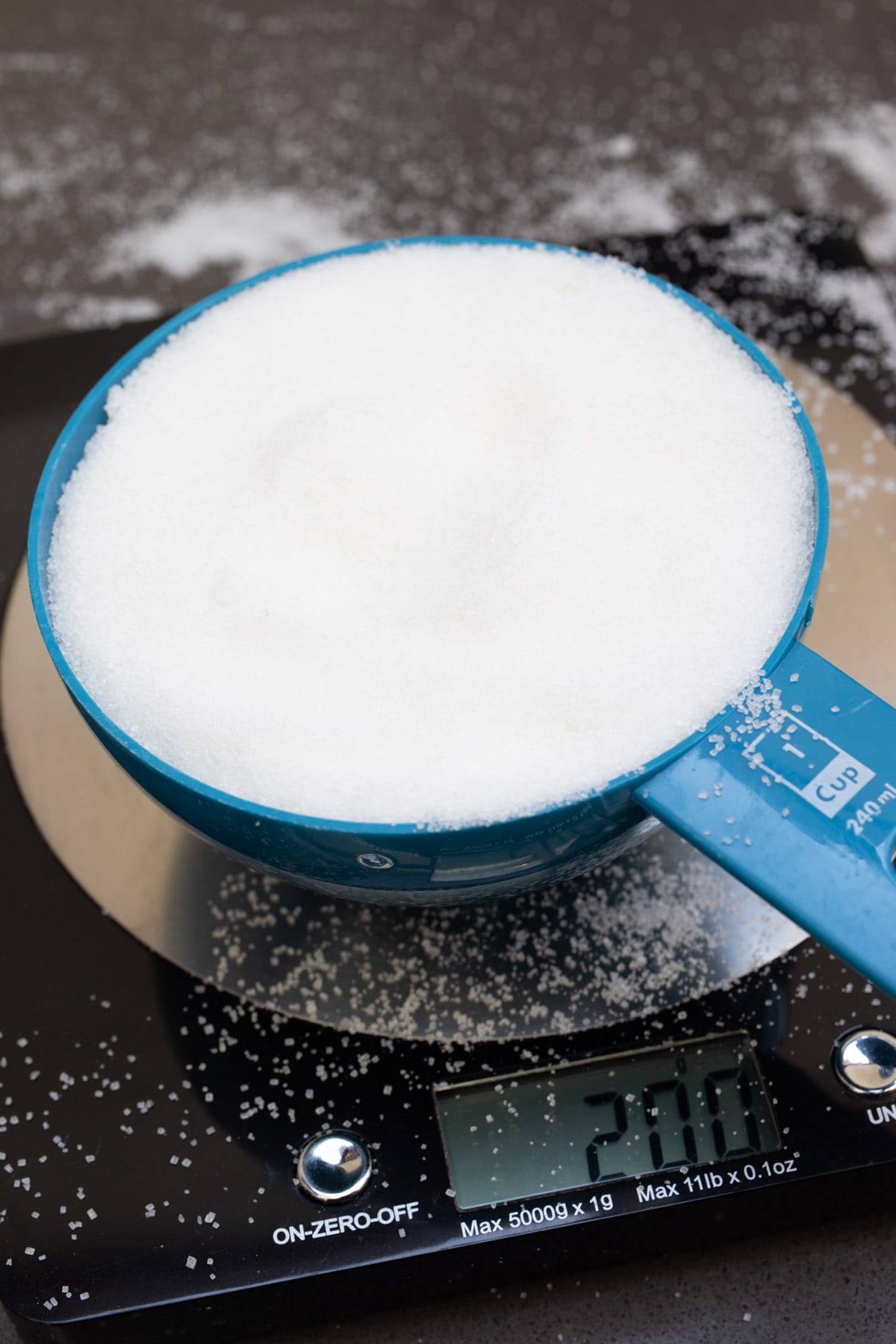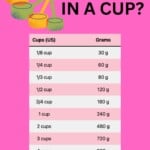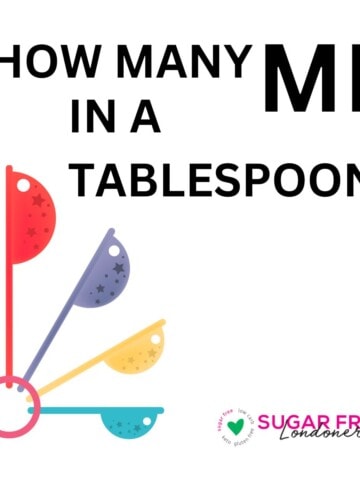Have you ever wondered how many grams are in a cup? This guide helps you convert measurements of common cooking and baking ingredients from cups to grams. It includes handy conversion charts so you can see the ingredient amounts at a glance.

I am sure you have been there, too. You are following a recipe online that lists ingredients in cups, tablespoons and teaspoons.
And the result is... underwhelming.
Most often, the reason for this is that measuring ingredients in cups is a lot less accurate than measuring them by weight (grams). Especially in baking, it is very important to use precise amounts.
Think about it: You can gently scoop flour into a cup. Or, you can compact it by pressing it down. If a cup is packed, it will hold a lot more flour.
Or, you may not be aware that a cup is a standard unit of measure and not your favourite tea cup!
Luckily, it is easy to level up your baking game by simply converting cups into grams.
Let's get into the details about cups to grams conversions.
Jump to:
Metric System and US Customary System
There are two main systems for measuring volume and weight used in the world today.
One is the United States Customary System, which is mainly used in the United States. The other one is the Metric System (also called SI System or International System of Units), which is used in most other countries.
The Metric System measures weight in grams and kilos.
The US Customary System, which is derived from the British Imperial System, measures in cups, tablespoons (tbsp) and teaspoons (tsp). Sometimes, weight or mass is also measured in ounces (oz).
What Is A Gram?
1 gram (originally called gramme) is equal to one-thousandth of a kilogram. Also, there are 1000 milligrams in a gram.
Grams can be used to measure both solid and liquid ingredients.
The best way to measure grams is with digital kitchen scales.
What Is A Cup?
There are different types of cups: The US measuring cup, the Metric cup, the British cup and, of course, your favourite coffee cup.
In the United States, a standard 1-cup measuring cup has a defined size. It is equal to 16 tablespoons, ½ pint, ¼ quart or 8 fluid ounces.
A US cup is exactly 236.588 ml, which is rounded up to 240 ml or 240 grams (if measuring liquids in weight).
The cups you use to drink coffee or tea can have all kinds of sizes. Using these for measuring will most likely not be accurate. My coffee cup is huge!
The standard volume of a British or Metric cup is 250 ml (or 240 g). However, recipes in the UK, Europe, Australia, Canada, New Zealand and other countries generally use grams instead of cups.
When we refer to cups on Sugar Free Londoner, we ALWAYS mean US measuring cups.
Grams To Cups Conversion Chart (Liquids)
This table shows at a glance how many grams are in a cup when measuring liquids.
Most liquids have the same (or very similar) weight. This includes water, tea, coffee, juice, broth and any other clear or mostly clear liquid.
It makes it easy that for these liquids, grams and ml are interchangeable:
1 cup = 240g = 240ml.
Note that smaller amounts than ¼ cup are usually measured in tablespoons. Find out here how many ml in a tablespoon.
| Cups (US) | Grams | Ounces |
|---|---|---|
| ⅛ cup | 30 g | 1 oz |
| ¼ cup | 60 g | 2 oz |
| ⅓ cup | 80 g | 2.7 oz |
| ½ cup | 120 g | 4 oz |
| ¾ cup | 180 g | 5.6 oz |
| 1 cup | 240 g | 8 oz |
| 2 cups | 480 g | 16 oz |
| 3 cups | 720 g | 24 oz |
| 4 cups | 960 g | 32 oz |
| 5 cups | 1200g | 40 oz |
Dry Ingredients 1 Cup To Grams
Here are common dry ingredients that are often used in baking. As you can see, their weight differs according to their density.
| Ingredient | Cups (US) | Grams |
|---|---|---|
| Wheat Flour | 1 cup | 120g |
| Almond Flour | 1 cup | 100g |
| Coconut Flour | 1 cup | 120g |
| Ground Flaxseed | 1 cup | 120g |
| Cocoa Powder | 1 cup | 86g |
| Granulated Sugar or Sweetener | 1 cup | 200g |
| Powdered Sweetener | 1 cup | 160g |
| Pumpkin Seeds | 1 cup | 129g |
| Sunflower Seeds | 1 cup | 140g |
| Chocolate Chips | 1 cup | 175g |
Wet Ingredients 1 Cup In Grams
This table shows common wet ingredients often used in baking.
| Ingredient | Cups (US) | Grams |
|---|---|---|
| Butter | 1 cup | 227g |
| Peanut Butter | 1 cup | 260g |
| Yogurt | 1 cup | 250g |
| Heavy Cream | 1 cup | 240g |
| Olive Oil | 1 cup | 216g |
| Honey, Syrups | 1 cup | 339g |
| Cream Cheese | 1 cup | 240g |
Expert Tips For Measuring With a Cup
When recipes require using cups and you don't have kitchen scales, use the following tips:
Flours and other dry ingredients: If necessary, stir the ingredient first to break up any clumps. Then, spoon or pour it directly into the cup. Do not use the cup to scoop - this can cause the ingredient to compact. Then, level the top with a knife so the ingredient is even with the top edge of the cup.
Liquid ingredients: If available, use liquid measuring cups. These have a spout at the top to make pouring easier. Check the cup at eye level to ensure the liquid is at the same level as the measuring mark. If using dry measuring cups, fill the cup to the brim.
Semi-liquid ingredients: Yogurt, peanut butter and other "wet ingredients" should be scooped or spooned into a dry measuring cup. Level with a knife.
Why Use Grams Instead Of Cups?
The issue with measuring cups is that you can get inconsistent amounts. This is not much of a problem when you are cooking dinner and adding twice as many vegetables.
In baking, however, precise amounts are essential. If you use too much flour, your cakes, bread or cookies are going to be dry.
If you are a keen cook or want to get serious about baking, we recommend measuring with kitchen scales and converting cups into grams.
However, here on Sugar Free Londoner, we always list grams alongside cups so everyone in the world can make our recipes.




Lou Robinson
Thanks for this great writeup on weight conversions. Follow-on question with regard to eggs. In your cookbooks you have mentioned that you always mean “large eggs” unless otherwise specified. I know egg sizes are graded differently in the UK and the US.
Since you are also using US cup measures in your recipes so you also mean US large eggs?
Katrin Nürnberger
I use UK large eggs (unless I specifically mention that I used medium). It is interesting that you ask because I recently received this question on a different post. The majority of my readers are from the US, and I have a lot of baking recipes, which means many of my recipes use eggs. I very rarely receive comments by readers having issues with dry batter. That's why I would say that using US large eggs in my recipes will work as well.
harry
Hi, Katrin.
You point out in this article that, "measuring ingredients in cups is a lot less accurate than measuring them by weight (grams). Especially in baking, it is very important to use precise amounts".
If this is what you think, then why do all your recipes use the "less accurate" cups, tablespoons & teaspoons for measurements?
Katrin Nürnberger
As I explain in the article, many people use cup measurements instead of grams and they do not own digital scales. I want to serve everyone with my website and therefore include both measurements. You must have missed that bit!
harry
Thank you for the explanation, Katrin. It didn’t occur to me that some people may not have access to a set of scales. Your inclusion of cups makes perfect sense now.
Mary
Excelente. Gracias. Saludos desde Bolivia
Suresh
I'm really happy. I got so many things from here. All recipes are too good I try to make and it's perfect. Thank you.
Susan
Thanks for this. I always struggle knowing how to convert US recipes into grammes, especially butter so this is a Godsend. I have different "cups" at home and they all show different measures!
jk
Thank you so much for doing this for us, Katrin, I have switched from using the old cup and spoon to weighing whenever possible. Using so many more expensive ingredients now, I want to give myself and my recipes every advantage to turning out right that I can.
Blessings!
CindyG
Great job! I’m always having to measure out and weigh so I can get more accurate results. Thank you for making this available
Alison beer
I’ve been looking for one of these conversion tables for ages! I hate mix all my measurements and cups seem such an inefficient way to measure (or maybe I’m just picky). Thank you for this.
Rachel Mitchell-Denson
That is amazing, I didn’t know any of that! Thank you so much for taking the time to do this. So much appreciated Rachel